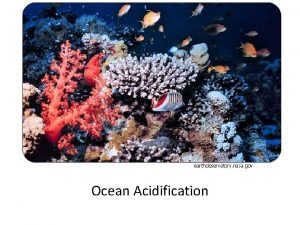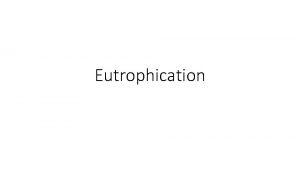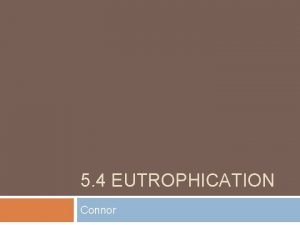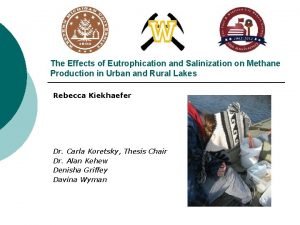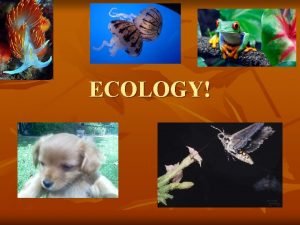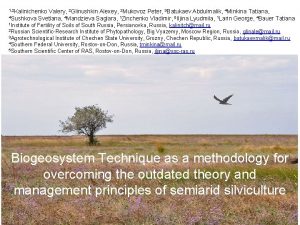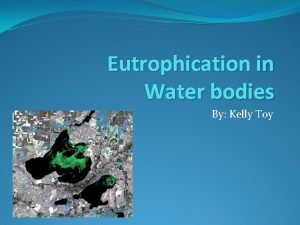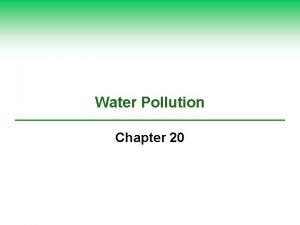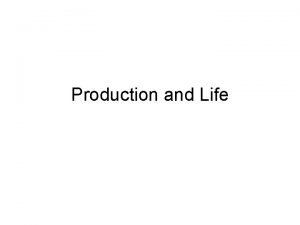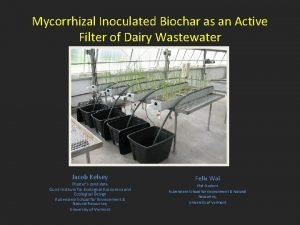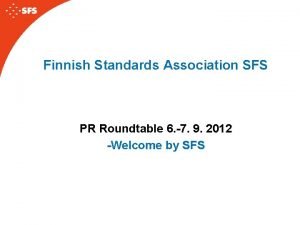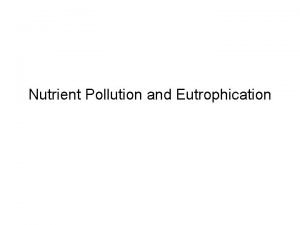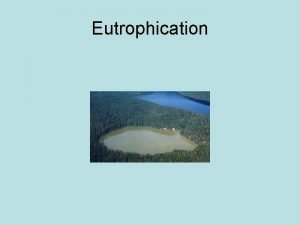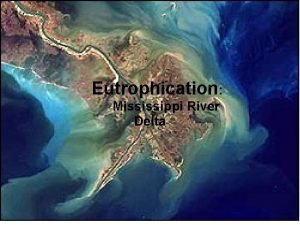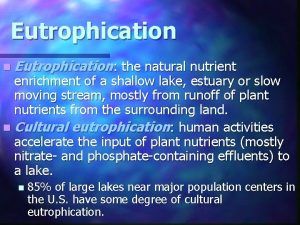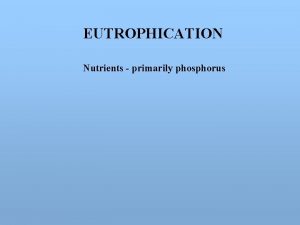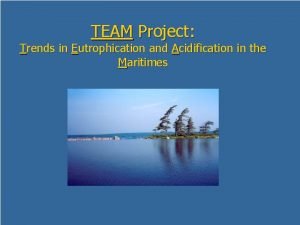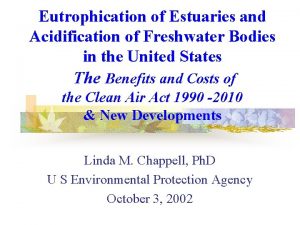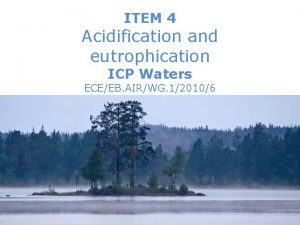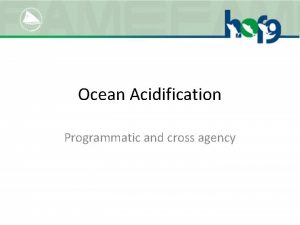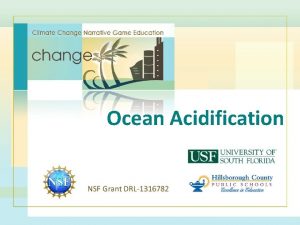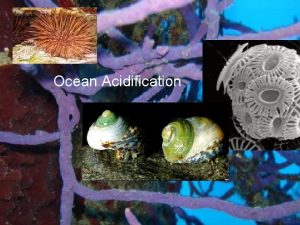Acidification and eutrophication studies Martin Forsius Finnish Environment
















- Slides: 16

Acidification and eutrophication studies Martin Forsius Finnish Environment Institute (SYKE) ICP IM Programme Centre 11/1/2020 ICP Integrated Monitoring

Main tasks load exceedances and empirical impact indicators at ICP IM sites § Biodiversity assessment – Literature review and first data analyses 11/1/2020 § Assessment of relationships between critical

Background loads have been instrumental in effectbased protocols to the UNECE CLRTAP. § For testing and validation of the key concepts in the critical load calculations, it is important to study the link between critical thresholds of acidification and eutrophication of the ecosystems and empirical impact indicators. 11/1/2020 § European databases and maps of critical

critical loads for acidification and eutrophication for aquatic and terrestrial ecosystems, and their exceedances (Ex. CL) 2) and present relationships between Ex. CL and surface water chemistry measurements at 18 -24 European ICP IM 11/1/2020 Study sites: European IM network 1) Calculate the site-specific

Materials and methods 1/3 • Acidification CLA: Steady State Water Chemistry (SSWC) (Henriksen and Posch 2001, UBA 2004) • Eutrophication CLnut. N: Mass Balance model for nutrient nitrogen (UBA 2004) • For a selection of 18 IM sites from 10 countries (AT, CZ, DE, EE, FI, GB, LT, LV, NO, SE) for which runoff water chemistry and runoff measurement data were available § Exceedances: deposition estimates at IM sites 11/1/2020 § Mass balance critical loads

Materials and methods 2/3 § CL for eutrophication: empirical (Bobbink and Hettelingh 2011) • Based on empirical studies on the response of natural and semi-natural ecosystems to nitrogen deposition. • CLemp. N are given for a groups of ecosystems, classified according to the EUNIS-European Nature Information System- habitat classification for Europe 11/1/2020 critical load of nutrient nitrogen CLemp. N

Materials and methods 3/3 • Acidification: annual average runoff water concentrations and fluxes in the period 2000 -2002 for key acidification parameters such as Acid Neutralising Capacity ANC = (Ca+Mg+Na+K) – (SO 4+Cl+NO 3), hydrogen-ion (H+) and non-marine sulphate (x. SO 4), • and eutrophication: total inorganic nutrient nitrogen (TIN = NO 3+NH 4) 11/1/2020 § Empirical impact indicators

Ex. CL: nr of sites protected/not protected in 2000 (NAT 2000 projection) Ex. CLA 13 11/1/2020 5 Ex. CLnut. N 4 14 Ex. CLemp. N 18 0 nr of 5 sites not protected 10 5 nr of sites protected 15 20 25

Good agreement between Ex. CLA and ANC and H+ 70 Conc. 3000 60 2000 1500 1000 500 -cc -0. 67 p < 0. 05 -500 -6000 30 20 -4000 -2000 0 0 -6000 2000 6000 450 5000 400 H+ (eq ha-1 yr-1) ANC (eq ha-1 yr-1) 40 10 0 Flux 50 4000 3000 2000 1000 -cc 0. 63 p < 0. 05 -cc -0. 84 p < 0. 05 0 -1000 -6000 350 -4000 -2000 0 2000 -cc 0. 60 p < 0. 05 300 250 200 150 100 50 -4000 -2000 0 Ex. CLA (eq ha-1 yr-1) 2000 0 -6000 -4000 Ex. CLA (eq ha-1 yr-1) 11/1/2020 2500 H+ (µeq L-1) ANC (µeq L-1) 3500

Ex. CLnut. N / Ex. CLemp. N vs. TIN (NO 3 + NH 4) 120 TIN (µeq L-1) Conc. 100 -cc 0. 61 p < 0. 05 80 60 40 0 -2000 TIN (eq ha-1 yr-1) Flux -1000 0 1000 2000 140 120 100 -cc 0. 35 p < 0. 1 80 60 40 20 0 -2000 -1000 0 Ex. CLnut. N (eq ha-1 yr-1) 1000 11/1/2020 20

Concluding remarks on CL studies exceeded § Instead, CLemp. N and CLnut. N were exceeded at 75 78% of the sites § There was a relatively good agreement between Ex. CLA and ANC and H+ in runoff water § Leaching of N was higher for sites with higher Ex. CLemp. N and Ex. CLnut. N § Evidence on the link between modelled critical thresholds and empirical impact indicators § Scientific paper in preparation, updated results will also be used for WGE ex-post scenario analyses 11/1/2020 § At the majority of the IM sites (72%), CLA was not

Biodiversity assessment monitoring and analyses made within the ICP IM subprogrammes Trunk epiphytes (EP), Aerial green algae (AL), Understory vegetation and trees on intensive plots (VG) and Vegetation structure and species cover (VS). § Preliminary results of data analyses. § Results presented in ICP IM Annual Report 2011. 11/1/2020 § Review of published results from

11/1/2020 Relationship between significant time trends of forest floor species and Ellenberg indicator values N (nutrient availability), R (soil p. H), L (light availability), F (moisture)

11/1/2020

§ § § more affected than in the Nordic countries. Algae or lichens differ in their suitability as indicators. At low deposition sites, algae may be more suitable as indicator than lichens. Species changes are highly variable between sites. The found significant changes are restricted to few species and the relationship with air pollution is not very clear. Further analyses will focus on community changes and changes of diversity using indicators. The results will again be compared with CL exceedance. 11/1/2020 Concluding remarks on biodiversity studies § Lichens in high pollution regions in central Europe are

Thank you for your attention
 Ocean acidification
Ocean acidification Non calcifiers examples
Non calcifiers examples Eutrophication steps
Eutrophication steps Bbc bitesize eutrophication
Bbc bitesize eutrophication Point source pollution
Point source pollution Eutrophication
Eutrophication Phosphorus cycle diagram
Phosphorus cycle diagram Eutrophication
Eutrophication Eutrophication
Eutrophication Eutrophication
Eutrophication Eutrophication
Eutrophication Eutrophication
Eutrophication Eutrophication
Eutrophication Paradigm shift from women studies to gender studies
Paradigm shift from women studies to gender studies Finnish cultural foundation grants
Finnish cultural foundation grants Finland facts and information
Finland facts and information Finnish standards association
Finnish standards association

